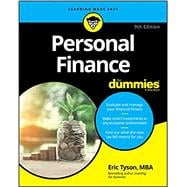Take stock of your financial situation
From budgeting, saving, and reducing debt, to making timely investment choices and planning for the future, Personal Finance For Dummies provides fiscally conscious readers with the tools they need to take charge of their financial life.
This new edition includes coverage of an extensive new tax bill that took effect in 2018 and the impact on individuals, families, small businesses, and on real estate and investing decisions. Plus, it covers emerging investing interests like technology and global investing, cryptocurrencies, pot stocks, the lifestyle changes occurring with millennials, and more.
- Evaluate and manage your financial fitness
- Assess your credit report and improve your score
- Make smart investments in any economic environment
- Find out about international investing
The expert advice offered in Personal Finance For Dummies is for anyone looking to ensure that their finances are on the right track—and to identify the areas in which they can improve their financial strategies.








